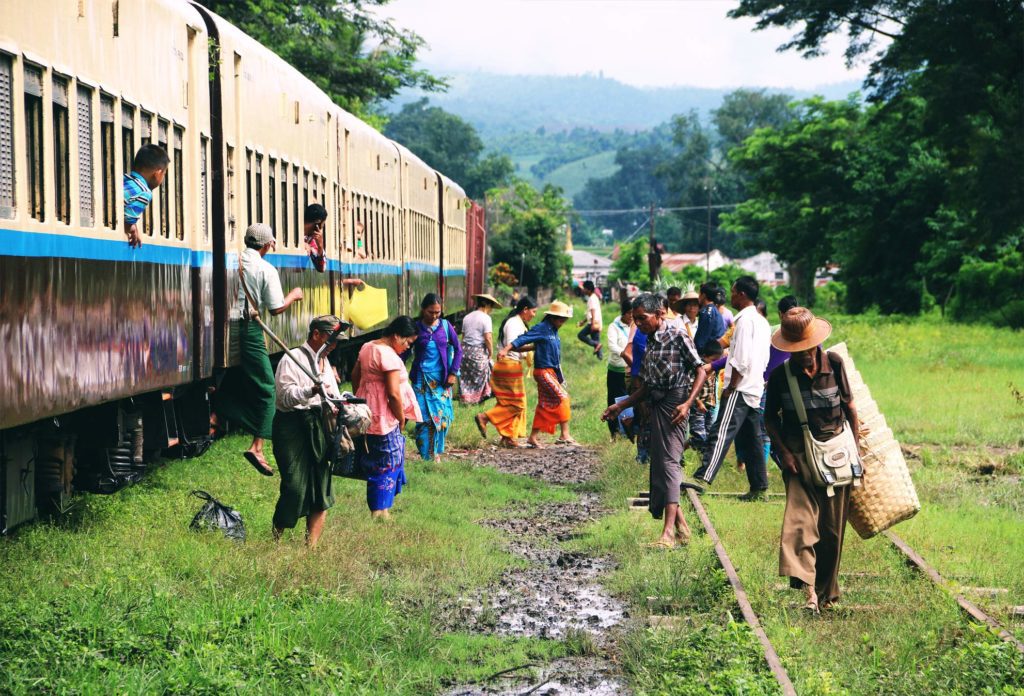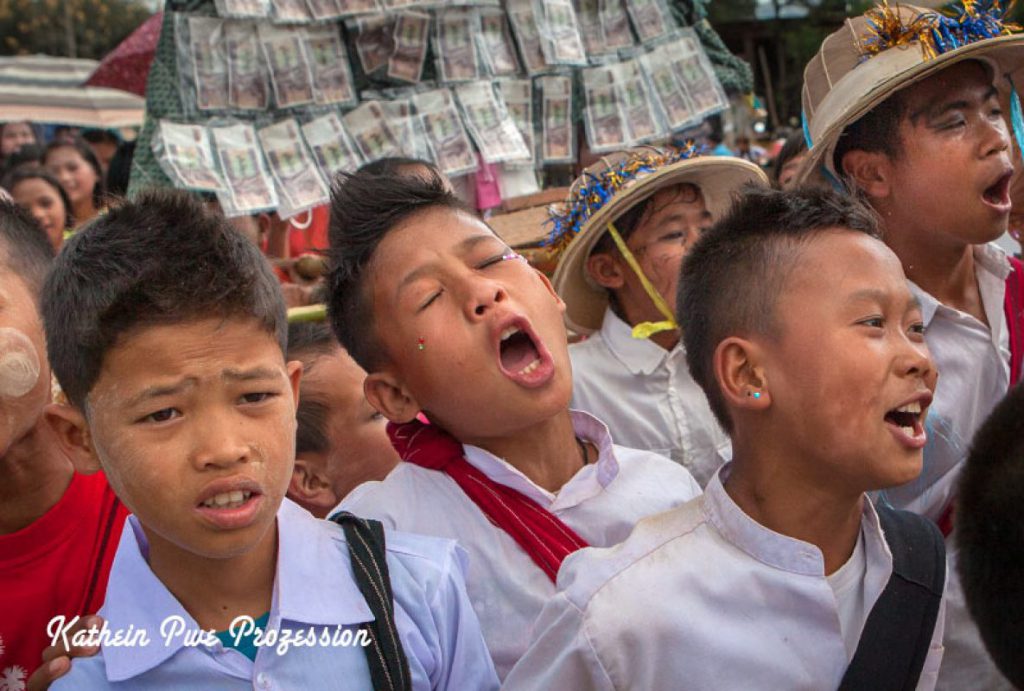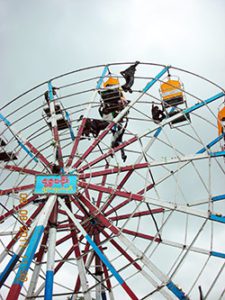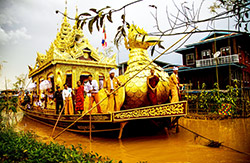Highlights of Myanmar
Encouters with tribal people
There are great differences between the more than 120 ethnic groups living in Myanmar. Among the country’s tribes, the Padaung, who call themselves Kayan, are certainly the most well-known. The female members wear a very extravagant necklace, which has made them famous all over the world. Many people who know little about them, give them idiotic names like giraffe women, Long Neck Karen etc. Come with us to see the Kayan in their villages in Kayah State – and not in the human zoos at Inle Lake or in Thailand!
Myanmar’s mountainous west offers great ethnic diversity, too. The linguistically extremely fragmented Chin have their own state up there. Their villages can be visited on a trip (usually from Bagan) to the holy mountain Natmataung (formerly Mt. Victoria, nearly 3.000 m high). It is also possible to make an excursion to some Chin villages from Mrauk U (Rakhine State). The northern neighbours of the Chin are the Naga, a large tribe. They settle on the upper reaches of the Chindwin River as well as in neighbouring India. A trip to their villages would usually start in Khamti. This town has an airport, which saves you the long journey up the Chindwin River on uncomfortable boats.

In the surroundings of Inle lake the Intha can be found. They have transformed their aquatic homeland, the lake, into a small paradise. In the surrounding mountains live many Pa-O, members of a very large tribe. Their women often wear traditional costumes. The Taung Yoe, Danu, as well as the above mentioned Palaung and others live around the lake. The tribes Lisu, Akha, the Palaung, the Lahu Na, the En and Loi Wa and the different Kachin peoples round up the list. En and Loi Wa and the different Kachin peoples round up the list.
Trekking
As a rule, the bikes offered by the local hirers are sufficient. Mountain bikes are on offer as well, and in Bagan e-bikes have become increasingly popular.
Motorcycles can be rented in the major tourist destinations such as Mandalay, Bagan or Lake Inle. They are available at the beaches and in Hsipaw, too!
In general, the legal situation is not clear: basically, foreigners may not be allowed to ride motorcycles at all in Myanmar.
But this applies to many things in Myanmar – and nobody seems to care… An international driving license is absolutely essential.

Balloonflights
Balloonflights are becoming more and more popular in Myanmar! While for a long time there was only one company offering ballooning in Bagan, nowadays several companies are sharing this lucrative market. In addition to the well-tried balloon journeys over Bagan, nowadays there are also balloon rides over Mandalay, Inle Lake and even the beach at Ngapali.
The balloon trip over Bagan, however, is warmly recommended to our customers! The balloon floats over the temples of Bagan – an unforgettable experience! The price is relatively high (about US$ 300 per person) and usually there’s a long waitlist. The duration and the length of the trip depend very much on the wind regime.
Train journeys

In addition to the main route mentioned above, the routes from Thazi (south of Mandalay) to Shwenyaung (Inle Lake) and from Yangon to Mawlamyaing are also interesting for tourists. The latter one was recently extended to Dawei. A ride from Mandalay to Lashio over the famous Gokteik Viaduct in Northern Shan State Very is very popular with tourists. Those who have time to kill leisure can get on in Mandalay and then go all the way to Lashio. Or get down at Hsipaw?

The Ayeyarwady Delta
The Ayeyarwady starts branching out into a total of seven estuaries near the town of Henzada, about 200 km from the Andaman Sea. The easternmost of them is the Yangon River (where the city of the same name is located), the westernmost the Pathein River. The mouths of those two rivers are about 200 km apart. The river delta annually expands sixty(!) metres into the sea. It is Myanmar’s rice bowl and one of the most densely populated regions of the country. The delta offers a fascinating mix of cultural and natural landscapes, vast rivers and winding waterways overgrown with mangroves and Nipa palms. Sleepy villages connected by water buses line the banks of the rivers and canals that cross the delta. During our relief action (see ‘About us’) we got to know the beauty of the Delta – but also its problems – first hand. And since then we have been offering trips to the Delta to our clients.
Forgotten Kingdoms (Arakan)
Arakan (Rakhine) State is located in the west of Myanmar. It occupies a narrow, fertile stretch of coastline stretching from the Naaf River (the border with Bangladesh) in the north all the way to the Ayeyarwady Delta in the south. The nearly impassable Arakan mountain range separates it from the Burmese heartland. According to the 2014 census, the state has about 3.2 million inhabitants, spread over an area of almost 37,000 square kilometers, giving it a population density of 84 per sqkm – slighty more than the country’s average. The majority of the population belongs to the Tibeto-Burman Rakhine ethnic group, which follows Theravada Buddhism. In addition, there is a large minority of Muslims of Bengali origin. Some of them (the so-called Rohingyas) have been living in this area since centuries, others migrated more recently – and they are at the centre of the recent troubles. Many Muslims were not recorded during the 2014 census because they refused to be registered as Bengali instead of Rohingya. So it is hard to tell their percentage of the state’s population. The majority of Arakan’s people live in the north of the state, especially in the vicinity of the state capital Sittwe up to the border of Bangladesh. The main attractions of the state, especially the old capital Mrauk U and its surroundings, are also located in this area. In addition, Arakan has some of the most beautiful beaches in Myanmar.
Its relative isolation from Myanmar’s heartland has promoted the emergence of a separate Arakanese culture, which differs from Burmese culture, even though they belong to the same ethnic group. The Arakanese language is essentially a dialect of Burmese. Both the old name, Arakan, and the common name Rakhine probably go back to the same root: ‘Land of demons’ (Rakshas). This name was most probably given to the country by the first settlers from India. They encountered peoples who had remained at the level of hunter-gatherers. We may rightly assume that they were Chins and Negritos. The former have their own state within the Union of Myanmar nowadays, while the latter have disappeared from South East Asia’s mainland and can only be found in remote places such as the Andaman Islands. Those natives were considered as demonic peoples by the newcomers from India. We may assume that they served as models for the Bilus (cannibal) statues found throughout Myanmar: they have curly hair, big round eyes and protruding jaws with fangs. Nowadays they serve predominantly as guardian spirits at temples and other sacred sites.
The country’s culture was dominated by neighbouring India for a long time: we differentiate between the Dhanyawati period (4th century BC to 6th century AD) and the Vesali period (6th to 8th century AD), each named after their capitals. In the 9th century AD, Tibeto-Burman tribes began to migrate into the area, subjugating the local population and establishing several city-states. During the Bagan period (11th-13th century AD), the area was tributary to the kings of Bagan. After the decline of the Bagan Empire (1287) the city state of Mrauk U (founded in the early 15th century) emerged as the leading power in that area. It dominated Rakhine until the end of the 18th century. At the peak of its power (16th and 17th century) Mrauk U’s kings controlled the entire coastline from Cape Negrais in the south up to Chittagong (nowadays Bangladesh) in the north.
Its power base was the fertile, well-irrigated rice-growing areas of the Kaladan and its tributaries (rice is still the main pillar of Arakan’s economy) as well as the control of the sea routes from India to the east. In the second half of the 17th century Mrauk U began to decline and in 1784 it was conquered by the Burmese. However, the victors could not enjoy their spoils for very long: forty years later, after the First Anglo-Burmese War, the Arakan was annexed by the British East India Company and remained under British control for more than a hundred years.
During WW II, Arakan was heavily contested between the British and the Japanese. When the Union of Burma gained independence in 1948, Arakan became a province of the newly created state – even though quite a few Arakanese would have wanted independence for Arakan. The Muslims in the north would have preferred an independent state, too, or at least join East Pakistan (nowadays Bangladesh) as they saw no future for themselves in a state dominated by Buddhist. The discovery of vast natural gas fields off the coast of Rakhine has turned once sleepy regions of Arakan State (such as Kyaukphyu Island) into busy centers of activity. A newly built double pipeline (gas and crude oil) leads from the island all the way to Kunming (China). In any case, the northern neighbour is very active in this area, which has led to some concern in Myanmar (economic domination!). The development of a SEZ (Special Economic Zone), which mainly serves Chinese interests, has also aroused fears in neighboring India that China wants to create a naval base on the Bay of Bengal, which would run counter to Indian interests.
References: Pamela Gutman’s ‘Lost Kingdoms of Burma’ is a very good introduction to the history and art of Arakan. Maurice Collis’: ‘Land of the Great Image’ is an adventure story that takes the reader back in time to 17th century Mrauk U…
Myanmar's festivals


Myanmar people like to party a lot. The most important festival is the Water Festival (Buddhist New Year), which takes place every year in mid-April. Officially, it’s ‘only’ a five day holiday (from 13 to 17 April all shops are closed). However, while you’re at it you might as well celebrate the whole week through – and so five days become eleven!
Generally, Burmese people don’t like to miss any opportunity for partying. I remember one year, when we celebrated no less than six New Year’s Eve: Karen New Year, Muslim New Year, Chinese New Year, Water Festival, and then Karen and Muslim New Year again (Lunar Calendar).
But that’s not all: minorities like Hindus (Deepavali is a public holiday!) of course, also celebrate their religious festivals and close their shops on this occasion. Just like the Chinese. 1. January is not an official holiday but from then it’s only three days until Independence Day. Basically, the moon phases (full moon, crescent moons and new moon) are holidays (Upo), on which schools and markets are closed – but at least these days are made up for! Other holidays include Army Day, Farmer’s Day and Martyr’s Day, just to name a few. As a result, we’ve already considered creating a calendar that only mentions the days that are no public holidays.
But jokes aside, in Myanmar you should definitely make sure that an unexpected holiday doesn’t puts a spoke in your planning. This may have unpleasant consequences, e.g. if you want to visit a government office or your embassy (embassies like to co-celebrate…) – only to find the office closed when you arrive.

(Buddhist New Year, April 13-17) is the most important festival of the year. It is celebrated not only in Myanmar, but also in neighbouring Buddhist countries such as Thailand, Laos and Cambodia. The hot season is coming to an end and not infrequently it is during this time that the first rains fall. Grandstands (mandap) are set up all over the country, sometimes with bands or groups of dancers, and the revelers up there will splash all passers-by from above until they are completely soaked. And as this is a tit-for-tat game they will get their fair share, too! The whole extravaganza is accompanied by deafening disco music and female dancers scampering up and down the stage.
This spectacle is definitely worth seeing, but you should make sure to pack your camera waterproof. In addition, the customs are getting harsher as ice packs and shaving cream are used. Many of the revelers are drunk and potentially aggressive. Even the otherwise (apparently) rather timid Burmese girls forget their decent upbringing – the highest number of unwanted pregnancies occur during the water festival. So be careful! But you should not miss out on the exuberant fun, if you are in Myanmar at that time. In big cities like Yangon and Mandalay the celebrations are the wildest but also in smaller places people want to celebrate in style! Why don’t you rent a truck, invite a few friends, get enough water on board and be well equipped with water guns – and the party can start.
 

Every pagoda in the country celebrates its festival once a year. The big and famous pagoda festivals (like Shwedagon, Mahamuni/Mandalay or some in Bagan) are spectacular and at first glance resemble a funfair more than a religious celebration with fairground rides, lottery stalls, traveling theaters, food stalls and traders offering all sorts of things: Thanaka, the traditional beauty paste, woolen blankets from Pakkoku as well as the huge Martaban jars. However, the religious background must not be neglected either: feeding of monks and donations to monasteries enhance the festival, which attracts visitors from near and far.
The Shwedagon Pagoda Festival takes place in January near the Great Pagoda in Yangon, about the same time as the Ananda Pagoda Festival in Bagan. In February, the Mahamuni Pagoda Festival follows and in November, the Shwezigon Pagoda Festival in Bagan – to name only the most significant. Worth a visit, too, are the smaller pagoda festivals, if you happen to be there at that time. Here you can a deeper insight into the soul of the Burmese people.
Truly spectacular festivals take place in the months of October and November during the Burmese months of Thadingyut and Tazaungmon, when the first and the second festival of lights are celebrated. The First Festival of Lights (Full Moon of Thadingyut) recalls the descent of the Buddha Gautama from Tavatimsa Heaven, where he preached to the gods and other inhabitants of that abode during the Buddhist Lent. In order to help the Buddha finding his way back to earth, plentiful lights were lit on earth. It became a tradition, and until this very day public buildings, pagodas and private houses are illuminated colorfully. The Full Moon of Thadingyut is especially atmospheric at Golden Rock in Mon-State, when the sanctuary and the entire platform are lit by countless candles and thousands of pilgrims crowd the place.

The most spectacular festival of this month, however, takes place at Inle Lake: the Phaung Daw Oo Boat Festival! People from all over Southern Shan State flock there to celebrate for more than a fortnight. Many tourists will come to this spectacle, too.
On this occasion, four particularly sacred Buddha statues that are usually kept in the Phaung Daw Oo Temple, the spiritual center of the lake-dwelling Intha people, will be rowed from village to village in a colorful ceremony. The Buddha statues are transported on a magnificent boat that resembles the holy Karaweik bird. It is propelled forward by numerous leg rowers. Around this boat an armada of smaller boats, manned with dancers and musicians delight the crowd. And thousands of onlookers, of course! Unfortunately, most of the boats are powered by ancient, smoldering, stinking diesel engines, so that we would almost recommend taking along a gas mask… The picturesque Shwekyin Lantern Festival in the village of the same name in Bago Region is certainly worth a visit, even though it is somewhat remote and requires a longer journey. Rowing competitions are at the center of the festivities and in the evening the locals float entire fleets of flower arrangements with candles on the river. It is a fantastic sight to see them drifting slowly downriver.
In the following month (Tazaungmon) the Second Festival of Lights is celebrated all over the country. Its origins go back to the pre-Buddhist Kattika Festival held in honour of the planetary gods. However, this does not keep the believers from celebrating it as enthusiastically as the First Festival of Lights. On the brightly lit pagodas competitions in robe weaving are held. They often last through the whole night. The women of several districts or villages compete for the honor of being the fastest in weaving a robe for an especially holy Buddha statue. Everywhere in the country you will see triangular wishing trees (padetha-bin). Here the faithful can place their donations for the monastery, be it money or practical things like monk robes, fans etc. Around full moon day, the wishing trees are taken to the monastery in a splendid ceremony; sometimes, you might even see a new magnificent Buddha statue for the monastery – extra merit for the karmic account…
Balloon festivals are also celebrated in this month. The most spectacular among them is, of course, the one held in Taunggyi, the capital of Southern Shan State. Over the course of ten days, hundreds of giant hot-air balloons will rise up to the sky. During the day, balloons in animal shapes will go up, while the colorfully decorated balloons with fireworks attached are soaring up at night, making the spectacle even more impressive. After the balloon has reached a certain height, a spectacular firework begins. Unfortunately, sometimes it does not exactly work as planned: it is not uncommon that the balloons do not gain height quick enough and so many a balloon unfolds its fireworks on the ground. Therefore, it is advisable keep your distance at the Taunggyi Balloon Festival … Similar festivals, albeit smaller ones, take place in other cities (such as Pyin Oo Lwin or Kalaw).
Our personal favorites among Myanmar’s festivals are the animistic Nat-Pwes. Nat (derived from the Sanskrit term Natha, which means ‘master’) is the general Burmese term for a whole, elusive group of spirits that can influence people’s lives. There are good spirits and evil ones and you should beware of the latter! And then there are ambiguous nats that may cause good as well as evil and whose favor can be secured with gifts of all kinds. An important group among the latter are the famous ‘37 Nats’. They are spirits of humans who have died unnatural deaths (eg by decapitation, accident, etc.) and therefore could find no peace and spook around in the human abode. Believers can communicate with these spirits by using the help of a spirit medium. These are called Natkadaw (spirit’s spouse) and can be both male and female. However, homosexual men dominate the trade, because – as they say – they can communicate with both female and male nats. How convenient! In their colorful shiny robes – in the West they would be called drag queens – they are a real feast for the eyes and when they move to the beat of infernal music (each nat has its own melody) they often fall into a trance. Or at least claim to do that. However, we have often experienced that dancers or viewers fall into trance-like states. Alcohol certainly plays an important role in the ritual.
Except for the most important ones (see below) nat-pwes are difficult to predict. Suppose someone wants to open a hardware store. In this case it does do no harm to make a good impression on Min Mahagiri, the terrestrial chief of terrestrial 37 nats, who was a blacksmith in his previous life. So the hopeful new businessman orders a nat pwe, pays about 300 dollars to the natkadaw and the ceremony starts. Satisfaction guaranteed! Since people may need the spirit’s help at all times, such festivals cannot be planned either. But there are certain places, eg. Hinthagon pagoda in Bago, where such ceremonies are held regularly, if the donor doesn’t want to have them at his residence.

The above said, however, does not apply to the great spirit festivals, among which Taungbyone’s is by far the largest and wildest. Hundreds of Natkadaws meet here, so it may be called a Natkadaw fair (in two words). Taungbyone is located about 30 km north of Mandalay, and if you happen to be in the area in August you should plan a visit. However, caution is advised, because the teeming crowd (e.g. in the main shrine dedicated to the two brothers ‘Inferior Gold’) , sensitive souls may suffer claustrophobic seizures. The natkadaws’ parade attracts thousands of visitors who come here to pay respect to their personal natkadaw. You’ve missed Taungbyone? No problem, in the ‘green season’, there are several spirit festivals near the last capital of the Burmese kings. For example, the Irinagu Festival in Amarapura, a former capital, or the Kyunpin-Nat-Pwe in Mingun on the west bank of the Ayeyarwady. Mt. Popa, too, is a stronghold of the spirit cult, where you can watch nat pwes at certain times of the year. If you are interested in attending a nat pwe, don’t hesitate to ask us. We are happy to organize a visit for you!
A very special experience for Myanmar’s visitors are consecration ceremonies. They correspond to similar ceremonies in other religions and mark the entry into the community of the faithful. Shinpyu ceremonies traditionally take place around the water festival in April, but there are good chances to see them at other times of the year.

Each Buddhist boy symbolically follows the Buddha’s path: first he is dressed in magnificent, princely robes, mounted on a horse (nowadays very often Toyota pickup will serve the same purpose) and led around in the village or the city quarter, accompanied by young girls and men, dressed in celestial costumes. Finally, the way leads to the local monastery: here the hair is shaved off and the princely dress replaced by a monk’s robe. Afterwards, the boy spends a few days in the monastery before returning to laity. For the proud parents, this is a very important occasion which has to be celebrated as pompous as possible. Since the ceremony is rather expensive, especially less wealthy people tend to have their sons consecrated in a big group in order to reduce the costs. So sometimes up to twenty novices come together and accordingly the feast is magnificent.
The festival of various minorities of Myanmar have already been mentioned in the chapter ‘Encounters with tribal people’. For those who are interested in Burmese theater, it may be worth visiting the Ramayana dance in the Delta city of Pyapon (compare ‘Delta’).
Myanmar's beaches

With a coastline of more than 2,000 km, it is not surprising that there are also some sections with beautiful beaches in Myanmar! We think they are among the most beautiful in the region. Why? Mass tourism hasn’t arrived yet and no skyscrapers disfigure the beaches.
